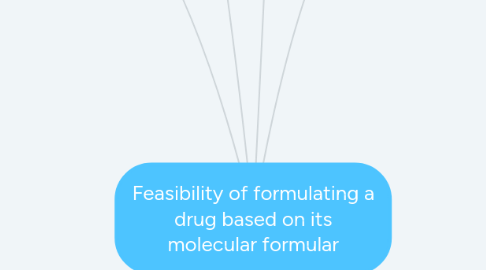
1. What information could be abstracted from a molecular formula?
1.1. Chemical Properties
1.1.1. Functional Groups
1.1.2. Tautomerism
1.1.3. Isomers
1.1.3.1. Optical
1.1.3.2. Geomatrical
1.1.3.3. Structural
1.2. Physical Properties
1.2.1. Molecular Weight
1.2.2. 3-D conformation
1.2.3. Number of Hydrogen Bonds
1.2.4. Number of rotatable bonds
1.2.5. Crystal Structure
1.2.6. Melting Point and Boiling Point
1.2.7. Solubility
1.2.8. pKa
1.2.9. Polarity
1.2.10. Electron Density
1.2.11. Electron Distribution
2. What information we need to know to predict the formulation of a molecule?
2.1. Bioavailabilty
2.2. Solubility
3. Biopharmaceutics Classification System
3.1. Class l
3.1.1. High Solubility
3.1.2. High Permeability
3.1.3. Immediate-release solid oral dosage form
3.2. Class ll
3.2.1. Low Solubility
3.2.2. High Permeability
3.2.3. More advanced formulation can be used
3.3. Class lll
3.3.1. High Solubility
3.3.2. Low Permeability
3.3.3. Immediate-release formulation in most of the case
3.4. Class lV
3.4.1. Low Solubility
3.4.2. Low Pemeability
3.4.3. Oral administration may not be possible
4. Are all these properties useful in predicting the formulation of a drug?
5. Is it able to predict the formulation based on the molecular formular?
5.1. No
5.1.1. There are couple models predicting the solubility and bioavailability
5.1.2. Too many limitation and results are not precise non accurate
5.1.3. Information abstracted form the molecular formula isn't enough to provide a promising prediction
6. Other factors affecting the formulation
6.1. Pharmcokinetic of drug
6.1.1. Absorption
6.1.1.1. Solubility
6.1.1.2. Permeability
6.1.1.3. Nature of Uptake
6.1.1.3.1. Passive Diffusion
6.1.1.3.2. Active Transport
6.1.1.3.3. Pinocytosis
6.1.1.3.4. Phagocytosis
6.1.1.3.5. Via Ion Channel
6.1.2. Distribution
6.1.2.1. Site of receptor
6.1.2.2. Number of compartment
6.1.2.3. Regional Blood Flow Rate
6.1.2.4. Molecular size
6.1.2.5. Polarity
6.1.2.6. Binding to serum protein
6.1.2.7. Any barriers? (i.e. Blood Brain Barrier)
6.1.3. Metabolism
6.1.3.1. Site of Metabolism
6.1.3.2. Enzyme involved
6.1.3.3. Drug interfering the metabolism
6.1.3.4. Function of metabolism origin
6.1.3.5. Rate of elimation
6.1.4. Elimination
6.1.4.1. Excretion route
6.1.4.2. Function of excretion origin
6.1.4.3. Rate of elimation
6.1.5. Toxicity
6.2. Pharmacodynamic of drug
6.2.1. Nature of receptor
6.2.2. Effect on receptor
6.2.2.1. Binding to allosteric stie
6.2.2.2. Binding to active site
6.2.2.2.1. Agonist
6.2.2.2.2. Antagonist
6.2.3. Mode of effect
6.2.3.1. Competitive
6.2.3.2. Non-competitive
7. AMDE is influenced by the administration method which is also partly determine the formulation of drugs
8. Models to access the bioavailability and solubility
8.1. Lipinski's Rule of Five
8.1.1. Drugs have poor absorption or permeation if
8.1.1.1. >500MW
8.1.1.2. >5 Hydrogen Bond Donors
8.1.1.3. >10 Hydrogen Bond Acceptors
8.1.1.4. cLopP>5
8.1.2. Strength
8.1.2.1. All information can gather from the molecular formular
8.1.2.2. Quick assessment could be made on molecule
8.1.3. Weakness
8.1.3.1. Drugs that are actively absorbed are excluded
8.1.3.2. Over simplified
8.1.3.3. Many drugs have large MW (>500)
8.1.3.4. Interaction of functional groups between solute and solvent wasn't considered
8.1.4. Future Work
8.2. Veber et al
8.2.1. Drugs have good bioavailability if
8.2.1.1. <10 rotatable bonds
8.2.1.2. <140Å
8.2.2. Strength
8.2.2.1. Requires few information from the molecular structure
8.2.2.2. Quick assessment could be made on molecule
8.2.3. Weakness
8.2.3.1. Limited use
8.2.3.2. Molecules with large MW tends to be poorly absorbed and solube
8.2.3.3. Interaction of functional groups between solute and solvent wasn't considered
8.2.4. Future Work
8.3. QSAR model
8.3.1. ΔlogD
8.3.1.1. Positive Value
8.3.1.1.1. Acid
8.3.1.2. Negative Value
8.3.1.2.1. Base
8.3.1.3. Bioavailability (%)
8.3.1.3.1. ≤20
8.3.1.3.2. 20-49
8.3.1.3.3. 50-79
8.3.1.3.4. ≥80
8.3.2. Strength
8.3.2.1. Bioavailability can be calculated
8.3.2.2. Formulation can be predicted directly from the bioabailabity
8.3.3. Weakness
8.3.3.1. Molecules with complex structure cannot be assessed by this model
8.3.3.2. Assuming all drugs undergo passive diffusion
8.3.3.3. Generic descriptors
8.3.3.4. Different descriptors will interfere each other and provide an invalid result
8.3.4. Future Wrok
8.4. Hansen Solubility Parameter
8.4.1. ΔD
8.4.1.1. Van Der Waals force of a molecule
8.4.2. ΔP
8.4.2.1. Polar Attribute and Dipole Moment
8.4.3. ΔH
8.4.3.1. Hydrogen Bonding (both acceptor and donor)
8.4.4. Application
8.4.4.1. The closer the value of solute and solvent, the higher chance for the solute to dissolve in the solvent
8.4.5. Strength
8.4.5.1. Could be programmed into a computer program
8.4.5.2. Graphical description of the paramters
8.4.5.3. Depending to their likeness
8.4.6. Weakness
8.4.6.1. Interaction of functional groups between solute and solvent wasn't considered
8.4.6.2. Molecular arrangement wasn't considered
8.4.6.3. Neglecting the size of molecules
8.4.6.4. Not applicable in all solvents
8.4.7. Future Work
8.5. UNIFAC Model
8.5.1. Activity Coefficient
8.5.1.1. Combinatorial Component
8.5.1.2. Residual component
8.5.2. Application
8.5.2.1. Predicting the solubility
8.5.3. Strength
8.5.3.1. Accurate in calculating the activity coefficient
8.5.3.2. Works in non-electrolyte solid in different solvents
8.5.3.3. Prominent estimation in system forming Hydrogen Bond
8.5.3.4. Taking interaction of functional groups into account
8.5.4. Weakness
8.5.4.1. Inaccurate in molecules with <100MW
8.5.4.2. Large complex molecules are not applicable as the functional groups are undefined or additively rule is invalid
8.5.4.3. Not applicable to electrolyte solutes
8.5.4.4. Not able to account for all functional gruops
8.5.4.5. Values of parameters were determined from VLE data
8.5.4.6. Cannot predict isomers nor structure with two or more strongly polar groups
8.5.5. Future Work

